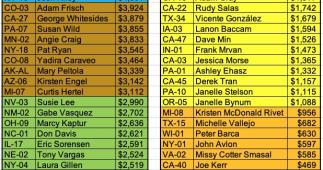
As I've written about numerous times, there's two schools of thought when it comes to which candidates Democrats should be donating to. The "pragmatic" philosophy says that you should only support winnable races--that is, candidates running in tossup districts/states, or at least in races where the demographics suggest a reasonable chance of victory instead of "wasting" resources on candidates who have little to no chance of winning.
The poster child for this was Amy McGrath in Kentucky in 2020, who had no chance whatsoever of beating Mitch McConnell but still managed to raise (and spend) a staggering $90 million trying...most of which should have been spread across dozens or hundreds of other races where the Democrat had a better chance of winning with a bit more support.
The "leave no Dem behind" approach involves spreading donations across every race, no matter how absurdly deep red the district or state is. The reasoning here is that if you abandon a district (or an entire state) it'll be that much more difficult to win back down the line.
In addition, there's a "reverse coattail" effect--numerous studies have proven that just having a Democrat on the ballot in November, any Democrat, helps boost Democratic voter turnout by a small but potentially significant amount vs. leaving the ballot blank...not enough for them to win, but enough to make the difference for a statewide race for Governor, U.S. Senate or President.
I try to split the difference between these two opposing philosophies in the following way:
- For STATEWIDE races (U.S. Senate, Governor, Atty. General, Sec. of State), I list every GOP-held seat. My reasoning is simple: Even the least-politically savvy donor generally understands that states like Alabama, Wyoming and Oklahoma are deep red, so if they choose to chip in a few bucks I trust them to have their reasons for doing so. I do, however, make sure to separate out the longshot states from the swing states in the description on the page.
- DISTRICT LEVEL races (U.S. House as well as State Legislatures) are a different story. Besides there simply being far too many to list every GOP-held seat (there's thousands of them nationally), it's also unreasonable to expect the average donor to know whether, say, Michigan's 54th State House district leans red, blue or purple. For these pages I mostly only list districts with PVI scores (the ranking of how red/blue the district leans generally) of +9 or lower, and I make sure to include those ratings in the description.
Having said that, there's another factor which someone just reminded me of: How desperate are the candidates for cash?
The short answer is, of course, that every campaign is scrambling to raise as much money as they possibly can. Even so, some candidates are far more flush than others, even within the "swing district" range.
With that in mind, I've taken a look at the Daily Kos Elections roundup of FEC fundraising reports for U.S. House candidates as of the end of the first quarter of 2024, and compared these to my own U.S. House fundraising page, which includes 50 tossup or competitive districts.
I'm not really interested in how much money each of the candidates has raised or spent, nor how much of it is self-funding. The only column I'm focusing on is how much money they actually had on hand as of March 31st (the most recent data available).
Here's how it breaks out. There are seven districts with highly contested primaries where I haven't added a specific candidate to the page. For the other 43, I've sorted them from least to most Cash On Hand, and have color coded them like so:
- Grey: Competitive primary still to come
- Orange: Less than $1 million on hand
- Yellow: Between $1 - $2 million on hand
- Green: Between $2 - $3 million on hand
- Red: Between $3 - $4 million on hand
- Blue: More than $4 million on hand
Of course it's possible that some of these candidates have seen their fundraising or COH fortunes change dramatically since the end of June, but this is the best I can do for now. It's also important to remember that just because a candidate has a lot of cash in the bank doesn't mean that they won't need more--some races are more expensive than others.
Having said that, if you want to base your donation decisions on the COH factor above all else, I'd recommend donating to the candidates in ORANGE and YELLOW first:
